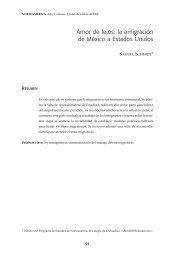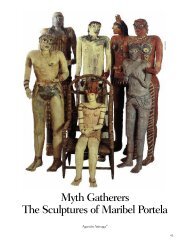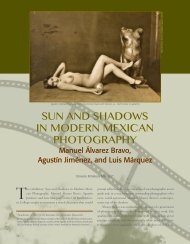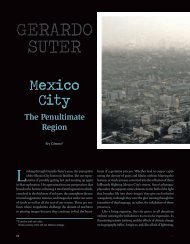Flower Body1 - Revistas
Flower Body1 - Revistas
Flower Body1 - Revistas
You also want an ePaper? Increase the reach of your titles
YUMPU automatically turns print PDFs into web optimized ePapers that Google loves.
Yaqui girl.<br />
The deer is the master<br />
of the flower.<br />
76<br />
The<br />
<strong>Flower</strong> Body 1<br />
María Eugenia Olavarria*<br />
Cristina Aguilar**<br />
Erica Merino***<br />
The hitebi, or “traditional healer” in the Yoeme lan guage, 2 is the person who heals, who has receiv<br />
ed from God and other protecting entities like virgins and saints the gift of healing. This gift<br />
can manifest itself through dreams or experiences in which those entities or the hitebi’s<br />
relatives confer on him/her the status of healer.<br />
The universe of Yoeme traditional healing is preserved mostly by women, that is, inhab itants of the<br />
towns of Có corit, Tajimaroa, Vicam Estación, and Loma de Guamúchil in Mex ico’s northern state of<br />
Sonora.<br />
In Yaqui communities at least three different healing tradi tions<br />
coexist: allopathic med icine, Trinitybased Maria nist spiritu alism, and<br />
traditional healing. However, the latter con stitutes a stock of know ledge<br />
about the human body, con ception, and the cycle of life,<br />
passed down for generations, from the preHispanic Yaqui past,<br />
the Jesuit Catholic evange lization, and, in some cases, Western<br />
biomedical system.<br />
Yaqui theory about the body involves an entire set of<br />
notions, concepts, and representations revolving around the<br />
person’s image and attributes, gifts from God, from the deer,<br />
and from ancestors and relatives, as well as the recom pense the<br />
individual must offer, expressed in rites.<br />
It is said that in ancient times, bamboo spoke and said, “There<br />
will be men and women healers and I am going to help them; I am, so you<br />
know me, bamboo; I am going to help the people who have hemorrhages with<br />
my work.” This is why they say medicine was born when bamboo spoke.<br />
* Researcher at the Autonomous Metropolitan University De part ment of Anthropology,<br />
Iztapalapa campus, maruolavarria@prodigy.net.mx.<br />
** Instructor in a psychology project at the Autonomous Metropolitan Uni versity,<br />
Xochimilco cam pus, c_aguilar_rivas@ hotmail.com.<br />
*** Instructor at the Autonomous University of Mexico City’s Sciences and Hu manities<br />
High School, Free dom House cam pus, lluvia0411@yahoo.com.mx.<br />
Photos by Cristina Aguilar Rivas.
Yaqui healers have the ability to leave their bodies and cure from afar.<br />
In Yaqui communities<br />
at least three different healing<br />
tradi tions co-exist: allopathic<br />
med icine, Trinity-based<br />
Maria nist spiritu alism,<br />
and traditional healing.<br />
The same thing happens with certain animals and the products made from them. When God made<br />
the world, he also made roosters and hens to sing to the Christ Child. They were all there: basil,<br />
common rue, the rooster, the hen, and the healer. That is why when the Christ Child was born,<br />
so was the egg.<br />
The body of a Yoeme has a physical foundation, takaa, and two Godgiven properties<br />
that animate him/her: one common to all beings called güepul jiapsi, or “soul” or “spirit,”<br />
and another that is possessed only by certain individuals, the sea takaa, or “flower body.” The<br />
person’s life and health depend on the characteristics of each of these, and the ba lance between<br />
them and the takaa.<br />
In this sense, the takaa is the material part; it is the orga nic, visible and tangible entity<br />
with skeletal, nervous, and muscular systems from which fluids and secretions, sounds, smells, and<br />
humors emanate, and by definition, is sexualized. Being sexualized is not exclusive to the takaa: the<br />
sun, taa’a, is a man, and behind him is God. The sun is a man and the moon, a woman, that is jamut,<br />
“mother moon” or mala mecha in Yaqui. The sun is the father of all men, and the moon is the mother<br />
of all women. The moon is Holy Mary, and the sun is Apo Señor, the Lord.<br />
Man and the sun are strongly connected; even when a man is going to fight, he says with wrath,<br />
with hatred, “To morrow the sun will come up stronger, blazing strong.” This is what men say when they<br />
have problems with other men to show they are stronger than their foes.<br />
The soul or spirit, güepul jiapsi, is the air God gave to Man. When he created the world, he made<br />
a pair of monkeys out of clay, one white and the other brown; he blew into them and gave them life;<br />
in this way, he gave men the spirit that is the Holy Spirit. We have this spirit on the left, in the heart.<br />
The güepul jiapsi is the strength of the heart; it gives understanding and reason; it can exit during<br />
sleep, leaving the body at rest, but when it abandons it definitively, the takaa (physical body) dies<br />
because it is only a temporary abode for the güepul jiapsi. The spirit then continues in an exis tence<br />
that depends to a large extent on the activities and behavior the person had in life: it can go to the<br />
glory of God or do penance.<br />
The sea takaa, or “flower body” is the dual spirit that only certain individuals such as healers,<br />
dancers, and musicians have. When a Yoeme has sea takaa, it is said that he/she has two spirits and<br />
a gift from God. Whoever does not have this is considered kia polobe, a “poor little thing.” This<br />
property is manifested corporeally in different ways: it can be through white blotches on the nails,<br />
77
Pascola mask. Pascola mediates<br />
between Jesus and the devil.<br />
78<br />
Pascola and deer dancer and his wife.<br />
There is an angel who helps healers.<br />
When they see a sick person,<br />
suddenly they say, “Take this,”<br />
and the person gets well. It is as<br />
though they received a message<br />
about what they have to do.<br />
called sutum sewa or “flowers of the spirit”; or it can be when the individual, instead of just having<br />
one cowlick on his/her scalp, has two or more, usually on either side of the nape of the neck.<br />
At the same time, the healer find their link to the ancestors who gave them the gift and with<br />
their patron saint, Saint Ramos. One of these healers says, “At the age of seven, I started with my<br />
nana; she had sores and was lying on a straw mat. I said to her, ‘I’m going to cure you.’ [She answered]<br />
‘No; you’re just a little girl. How are you going to cure me?’ [Then] she lay down; she<br />
covered herself with a little cloth and went to sleep. I went up to her and I could see that a worm that<br />
was eating her flesh was sticking out of her sore. I grabbed the worm. She woke up and I said to her,<br />
‘Look, nana, what was inside you!’ Then I took it to my mama and told her, ‘Look, mama, what I took<br />
out of nana.’ ‘Oh, you’re making it up!’ She didn’t believe me, and I said to her, ‘You go over there and<br />
look at her and you’ll see.’ She went over to nana and saw that I wasn’t lying, so she said to me, ‘Maybe<br />
you’re going to be a healer.’”<br />
Being a healer is something the Creator himself chooses. There is an angel who helps healers.<br />
When they see a sick person, suddenly they say, “Take this,” and the person gets well. It is as though<br />
they received a message about what they have to do. They look at plants in a special way, not like<br />
everyone else. Their gift can come through a dream or in the midst of strange events, and that is when<br />
these people realize they can heal.<br />
Healers and plants come into contact through a genea logical chain that in most cases is expressed<br />
in dreams, and, less frequently, through visions when they are awake (this mostly happens<br />
to the elderly). One of them commented once, “I dreamed about seeds with little legs that completely<br />
covered my face; they didn’t frighten me because I knew they were medicinal plants revealing<br />
themselves to me. I almost always had this dream. This also happened to my mamá grande<br />
[grandmother]; she also had the same dream. After the dream I began healing my children because<br />
God had already given me this gift.”<br />
Healers also have the ability, and in a certain sense, the obligation, of transmitting that same gift<br />
through the act of healing. “I cannot stop being a healer,” said one interviewee, “because if I stop, I<br />
will die. God has given me this gift, this work of curing people, and if I leave it, then my God will take<br />
me. ‘If you’re not going to work, then, let’s go,’ he’ll say to me, and I don’t want to go be cause I’m<br />
very happy with my patients.”<br />
They enter into communication both with God and with the plants, like the case of the stone<br />
flower, a messenger from God who, they say, aids in deciding to treat or refuse a patient. The Yoeme
healer manipulates the polarities of the body through physical contact, her management of space,<br />
prayer, and the invocation of her supernatural helpers, the saints and the Virgin. For her, the human<br />
body is inscribed in a hierarchical polarity that creates two axes, one vertical and the other ho rizontal.<br />
Using the navel, siiku, as a refe rence, differentiated values are located: right (batataza), up<br />
(jikat), forward (bat), related to the east, or life; on the other side, the left (micoi), down (betukuni)<br />
and behind (amau), related to the west, or death. Thus, a healer’s altar must face the place where the<br />
sun rises because that is where light is born and there is life. It must not face the west because that<br />
means death. These positions are related to the way in which people are buried: the head must be<br />
facing east, and the feet, west, “because they must walk with the sun, from the time they are born<br />
until they die.”<br />
When a person recognizes him or herself as a healer, the saints and virgins, prayers, medicinal<br />
plants, incense burner, water, the egg, and the candle light can be replaced by his/her hands.<br />
Everything that constitutes the shrine and the altar is found in the body of the healer: the healer is<br />
the temple, the center. And for that reason, they say, we must follow the paths of God, regardless<br />
of whether we go to mass or not. The important thing is to do things right. The body is the church;<br />
every part has a task; the healer protects it with medicinal plants, and with the protector who is<br />
Jesus Christ.<br />
noTes<br />
1 Information for this article is from María Eugenia Olavarría, Cristina Aguilar, and Érica Merino, El cuerpo flor. Etnografía<br />
de una noción yoeme, Las ciencias sociales Collection (Mexico City: Miguel Ángel Porrúa/uam, 2009). This book was written<br />
with the support of the National Science and Technology Council (Conacyt) for the project “Kinship, Body, and Re production.<br />
Representations and Cultural Contents in the Context of Contemporary Mexico,” directed by María Eugenia<br />
Olavarría.<br />
2 The term yoeme is the generic ethnic name for Yaquis and Mayos; the Yaqui language variant uses yoeme for the singular<br />
and yoemem for the plural. In this text, we use the terms Yaqui and Yoeme synonymously.<br />
Chapayeca mask,<br />
used during Lent and Holy Week.<br />
79







